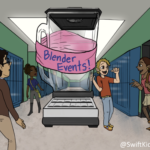Every hand in the room was in the air. I knew the number would be high, but I didn’t expect it to be 100%!
At a recent leadership program I ran at Gannon University, I asked the current campus leaders how many are in a leadership position because someone asked them to take on the extra responsibility.
100% of the hands in the room went in the air!
Everyone in that room was in their current role because they were asked by someone else. Most likely, that person was someone they knew and trusted, which makes sense because the more we know someone, the more we trust their influence.
If you want to increase your levels of engagement, especially at the e-board level, you need to ask your Trending Leaders to take on more responsibility. Of course, they will want to do it; they just need to get the spark, idea, or even permission, from you.
Regarding the Dance Floor Theory Engagement Pyramid, the 3s and 4s are the people within your community waiting for you to ask them.
4-Step Process to Keep a Healthy Pipeline of E-board Members from Year to Year
Spend Time Cultivating Relationships With Your Members:
The founding of Dance Floor Theory and Engagement Based Leadership is the strength and number of relationships built within your community. The more bridging and bonding social capital within your community, the more engagement and retention will happen.
Identify Who Your 3s and 4s Are Among Your Members:
Even within that subset of 3s and 4s, identify the Trending Leaders. If you turn over your e-board members yearly, consider who is next in line to step into a leadership role and who might be better off waiting a year.
Layout Who Would Be Suitable For All Open Positions:
This kind of groundwork will make the final step of this process, the ask, much more effective because you will be asking someone based on a perfect match of needs and skills.
Ask The Person:
The two of you should have a good relationship. Asking a question like this shouldn’t seem awkward. Instead, it should almost feel aspirational.
Some leaders do this process unconsciously and are great at it; however, most leaders I meet need to be made aware of how powerful a simple ask can be to increase engagement and retention within their organization.




